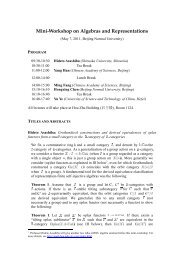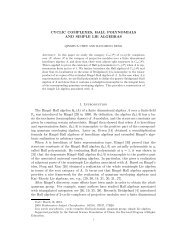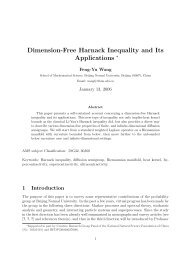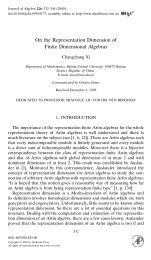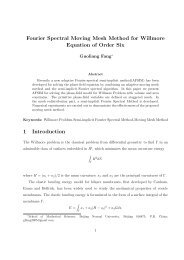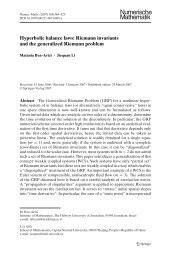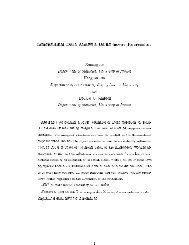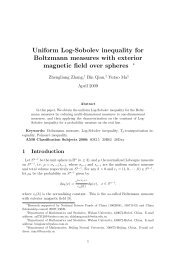Finite dimensional algebras and quantum groups
Finite dimensional algebras and quantum groups
Finite dimensional algebras and quantum groups
Create successful ePaper yourself
Turn your PDF publications into a flip-book with our unique Google optimized e-Paper software.
15at ema ·caSurvey<strong>and</strong>onographsoumelIII _.0= --0: ~ c:rIIIC»=' J.Q.0CI»=' rtC3ac"CIII
<strong>Finite</strong> DimensionalAlgebras <strong>and</strong>Quantum Groups
For all their help, encouragement, <strong>and</strong> infinite patience,we dedicate this book to our wives <strong>and</strong> children:Wenlian Guo <strong>and</strong> Zhuoran DengChunli Yu <strong>and</strong> Andy DuKaren ParshallHuiqing Xu, Xin Wang, <strong>and</strong> Yun Wang
<strong>Finite</strong> Dimensional Algebras <strong>and</strong>Quantum GroupsBangming Deng 1Jie Du 2Brian Parshall 3Jianpan Wang 41 School of Mathematical Sciences, Beijing Normal University,Beijing 100875, ChinaE-mail address: dengbm@bnu.edu.cn2 School of Mathematics <strong>and</strong> Statistics, University of NewSouth Wales, Sydney NSW 2052, AustraliaE-mail address: j.du@unsw.edu.au3 Department of Mathematics, University of Virginia, Charlottesville,VA 22904-4137, USAE-mail address: bjp8w@virginia.edu4 Department of Mathematics, East China Normal University,Shanghai 200062, ChinaE-mail address: jpwang@ecnu.edu.cn
2000 Mathematics Subject Classification. Primary 05E10, 16G20, 16W35,17B37, 20C08;Secondary 16G70, 20C30, 20G05, 20G42Key words <strong>and</strong> phrases. Algebra with Frobenius morphism, Cartan matrix,Hecke algebra, Kazhdan–Lusztig cell, <strong>quantum</strong> enveloping algebra,<strong>quantum</strong> gl n , <strong>quantum</strong> Schur algebra, quasi-hereditary algebra, quiverwith automorphism, representation, Ringel–Hall algebra.Abstract. This research/advanced graduate-level text combines, forthe first time in book form, the two theories given in its title. As a mainfeature, the book emphasizes the finite <strong>dimensional</strong> algebra approachto <strong>quantum</strong> <strong>groups</strong>. More precisely, it investigates the Ringel–Hall algebrarealization for the positive part of a <strong>quantum</strong> enveloping algebraassociated with a symmetrizable Cartan matrix <strong>and</strong> looks closely at theBeilinson–Lusztig–MacPherson realization for the entire <strong>quantum</strong> gl n .The book begins with the two realizations of generalized Cartanmatrices, namely, the graph realization <strong>and</strong> the root datum realization.From there, it develops the representation theory of quivers with automorphisms<strong>and</strong> the theory of <strong>quantum</strong> enveloping <strong>algebras</strong> associatedwith Kac-Moody Lie <strong>algebras</strong>. These two independent theories eventuallymeet, under the umbrella of Ringel–Hall <strong>algebras</strong>.Cartan matrices can also be used to define an important class of<strong>groups</strong> — Coxeter <strong>groups</strong> — <strong>and</strong> their associated Hecke <strong>algebras</strong>. Hecke<strong>algebras</strong> associated with symmetric <strong>groups</strong> give rise to an interestingclass of quasi-hereditary <strong>algebras</strong>, the <strong>quantum</strong> Schur <strong>algebras</strong>. Thestructure of these finite <strong>dimensional</strong> <strong>algebras</strong> is used to build the entire<strong>quantum</strong> gl n through a completion process of a limit algebra (theBeilinson–Lusztig–MacPherson algebra).
ContentsPrefaceNotational conventionsLeitfadenxiiixxiiixxvChapter 0. Getting started 1§0.1. Cartan matrices <strong>and</strong> their two realizations 1§0.2. Free <strong>algebras</strong> <strong>and</strong> presentations with generators <strong>and</strong> relations 6§0.3. Examples: the realization problem 12§0.4. Counting over finite fields: Gaussian polynomials 17§0.5. Canonical bases: the matrix construction 22§0.6. <strong>Finite</strong> <strong>dimensional</strong> semisimple Lie <strong>algebras</strong> 25Exercises <strong>and</strong> notes 34Part 1. Quivers <strong>and</strong> Their RepresentationsChapter 1. Representations of quivers 43§1.1. Quivers <strong>and</strong> their representations 44§1.2. Euler forms, Cartan matrices, <strong>and</strong> the classification of quivers 49§1.3. Weyl <strong>groups</strong> <strong>and</strong> root systems 55§1.4. Bernstein–Gelf<strong>and</strong>–Ponomarev reflection functors 60§1.5. Gabriel’s theorem 65§1.6. Representation varieties <strong>and</strong> generic extensions 70Exercises <strong>and</strong> notes 74vii
viiiContentsChapter 2. Algebras with Frobenius morphisms 83§2.1. F q -structures on vector spaces 84§2.2. Algebras with Frobenius morphisms <strong>and</strong> Frobenius twists 86§2.3. F-stable A-modules 91§2.4. A construction of indecomposable F-stable modules 94§2.5. A functorial approach to the representation theory 98§2.6. Almost split sequences 105§2.7. Irreducible morphisms 112§2.8. Frobenius folding of almost split sequences 117Exercises <strong>and</strong> notes 121Chapter 3. Quivers with automorphisms 127§3.1. Quivers with automorphisms <strong>and</strong> valued quivers 128§3.2. Automorphisms of Dynkin <strong>and</strong> tame quivers 135§3.3. Modulated quivers <strong>and</strong> Ausl<strong>and</strong>er–Reiten quivers 140§3.4. Preprojective <strong>and</strong> preinjective components 145§3.5. Modulated quivers attached to quivers with automorphisms 150§3.6. Frobenius folding of Ausl<strong>and</strong>er–Reiten quivers 156§3.7. <strong>Finite</strong> <strong>dimensional</strong> <strong>algebras</strong> over a finite field 164§3.8. Representations of tame quivers with automorphisms 170Exercises <strong>and</strong> notes 174Part 2. Some Quantized AlgebrasChapter 4. Coxeter <strong>groups</strong> <strong>and</strong> Hecke <strong>algebras</strong> 183§4.1. Coxeter <strong>groups</strong> 184§4.2. An example: symmetric <strong>groups</strong> 193§4.3. Parabolic sub<strong>groups</strong> <strong>and</strong> affine Weyl <strong>groups</strong> 197§4.4. Hecke <strong>algebras</strong> 203§4.5. Hecke monoids 208§4.6. Counting with finite general linear <strong>groups</strong> 212§4.7. Integral Hecke <strong>algebras</strong> associated with GL n (q) 218Exercises <strong>and</strong> notes 223Chapter 5. Hopf <strong>algebras</strong> <strong>and</strong> universal enveloping <strong>algebras</strong> 229§5.1. Co<strong>algebras</strong>, bi<strong>algebras</strong>, <strong>and</strong> Hopf <strong>algebras</strong> 230§5.2. Universal enveloping <strong>algebras</strong> <strong>and</strong> PBW bases 239
Contentsix§5.3. Universal enveloping <strong>algebras</strong> of Kac–Moody Lie <strong>algebras</strong> 244§5.4. Symmetry structures of Kac–Moody Lie <strong>algebras</strong> 247§5.5. Braid group actions 252§5.6. Quantum sl 2 256Exercises <strong>and</strong> notes 263Chapter 6. Quantum enveloping <strong>algebras</strong> 271§6.1. Quantum enveloping <strong>algebras</strong> 271§6.2. The elementary structure of U 275§6.3. The Hopf algebra structure of U 278§6.4. The adjoint action <strong>and</strong> triangular decomposition 283§6.5. Annihilators of integrable U-modules 289§6.6. Integrable U v (sl 2 )-modules <strong>and</strong> their symmetries 295§6.7. Symmetries of integrable U-modules 302§6.8. Symmetry of U <strong>and</strong> braid group actions 305§6.9. An integral structure 308§6.10. A PBW theorem for finite type 315Exercises <strong>and</strong> notes 318Part 3. Representations of Symmetric GroupsChapter 7. Kazhdan–Lusztig combinatorics for Hecke <strong>algebras</strong> 325§7.1. R-polynomials <strong>and</strong> Kazhdan–Lusztig bases 326§7.2. Multiplication formulas <strong>and</strong> Kazhdan–Lusztig polynomials 328§7.3. Inverse Kazhdan–Lusztig polynomials <strong>and</strong> dual bases 332§7.4. Cells 335§7.5. Knuth <strong>and</strong> Vogan classes 338§7.6. q-permutation modules <strong>and</strong> their canonical bases 342§7.7. Cell modules <strong>and</strong> the Ext 1 -vanishing property 349§7.8. The positivity property 353Exercises <strong>and</strong> notes 361Chapter 8. Cells <strong>and</strong> representations of symmetric <strong>groups</strong> 367§8.1. The row-insertion algorithm 368§8.2. The RSK correspondence 370§8.3. The symmetry of the RSK correspondence 375§8.4. Knuth equivalence classes in S r 379
xContents§8.5. Left cells in symmetric <strong>groups</strong> 382§8.6. The irreducibility of cell modules 388§8.7. An Artin–Wedderburn decomposition for H(S r ) Q(v) 392§8.8. A poset isomorphism 395Exercises <strong>and</strong> notes 399Chapter 9. The integral theory of <strong>quantum</strong> Schur <strong>algebras</strong> 405§9.1. The <strong>quantum</strong> Schur algebra 406§9.2. Specht modules <strong>and</strong> Specht data 412§9.3. Canonical bases for <strong>quantum</strong> Schur <strong>algebras</strong> 415§9.4. The cellular property of <strong>quantum</strong> Schur <strong>algebras</strong> 418§9.5. St<strong>and</strong>ard modules: canonical bases, duality, <strong>and</strong> beyond 423§9.6. The integral double centralizer property 427Exercises <strong>and</strong> notes 431Part 4. Ringel–Hall Algebras: A Realization for the ±-PartsChapter 10. Ringel–Hall <strong>algebras</strong> 437§10.1. Integral Hall <strong>algebras</strong> 438§10.2. Ringel’s fundamental relations 441§10.3. Ringel–Hall <strong>algebras</strong> 444§10.4. Hall polynomials 449§10.5. Generic Ringel–Hall <strong>algebras</strong> of finite type 456Exercises <strong>and</strong> notes 461Chapter 11. Bases of <strong>quantum</strong> enveloping <strong>algebras</strong> of finite type 467§11.1. Generic extension monoids 468§11.2. Reduced filtrations <strong>and</strong> distinguished words 472§11.3. Monomial bases 478§11.4. Reflection functors <strong>and</strong> sub<strong>algebras</strong> of Ringel–Hall <strong>algebras</strong> 483§11.5. The Lusztig symmetries <strong>and</strong> PBW-type bases 488§11.6. An elementary algebraic construction of canonical bases 494§11.7. An example: canonical basis of U + v (sl 3 ) 497Exercises <strong>and</strong> notes 500Chapter 12. Green’s theorem 505§12.1. Comultiplication on Ringel–Hall <strong>algebras</strong> 505§12.2. Some counting lemmas 511
Contentsxi§12.3. Proof of Green’s formula 516§12.4. Green <strong>algebras</strong> <strong>and</strong> Lusztig’s theorem 523§12.5. Green’s theorem 527Exercises <strong>and</strong> notes 532Part 5. The BLM Algebra: A Realization for Quantum gl nChapter 13. Serre relations in <strong>quantum</strong> Schur <strong>algebras</strong> 537§13.1. n-step flags <strong>and</strong> the orbit–matrix correspondence 538§13.2. Dimensions of orbits 541§13.3. Orbits corresponding to almost diagonal matrices 544§13.4. A <strong>quantum</strong>ization for <strong>quantum</strong> Schur <strong>algebras</strong> 546§13.5. The fundamental multiplication formulas 550§13.6. Some partial orderings on Ξ(n) <strong>and</strong> ˜Ξ(n) 558§13.7. The BLM triangular relations 560§13.8. Extending the fundamental multiplication formulas 567§13.9. Generators <strong>and</strong> relations 572§13.10. Presentations for <strong>quantum</strong> Schur <strong>algebras</strong> 577Exercises <strong>and</strong> notes 587Chapter 14. Constructing <strong>quantum</strong> gl n via <strong>quantum</strong> Schur <strong>algebras</strong> 591§14.1. A stabilization property 592§14.2. The BLM algebra K <strong>and</strong> its canonical basis 595§14.3. The completion ̂K of K <strong>and</strong> multiplication formulas 598§14.4. Embedding U v (gl n ) into ̂K 602§14.5. Z-forms of U v (gl n ) 606§14.6. Integral <strong>quantum</strong> Schur–Weyl reciprocity 609§14.7. A connection with Ringel–Hall <strong>algebras</strong> 614Exercises <strong>and</strong> notes 617AppendicesAppendix A. Varieties <strong>and</strong> affine algebraic <strong>groups</strong> 623§A.1. Affine varieties 624§A.2. Varieties 630§A.3. Affine algebraic <strong>groups</strong> 633§A.4. Parabolic sub<strong>groups</strong> <strong>and</strong> the Chevalley–Bruhat ordering 643§A.5. Representation theory: a first view 645
xiiContents§A.6.Representations in positive characteristic; Frobeniusmorphisms 649§A.7. Induced representations <strong>and</strong> the Weyl character formula 654§A.8. Higher Ext functors; ∆- <strong>and</strong> ∇-filtrations 658Exercises <strong>and</strong> notes 660Appendix B. Quantum linear <strong>groups</strong> through coordinate <strong>algebras</strong> 669§B.1. Quantum linear algebra 670§B.2. Quantum linear <strong>groups</strong> 677§B.3. Multiparameter <strong>quantum</strong> matrix spaces 683§B.4. An application: <strong>quantum</strong> Schur <strong>algebras</strong> 691Exercises <strong>and</strong> notes 695Appendix C. Quasi-hereditary <strong>and</strong> cellular <strong>algebras</strong> 699§C.1. Heredity ideals 700§C.2. Quasi-hereditary <strong>algebras</strong> <strong>and</strong> highest weight categories 704§C.3. Regular rings of Krull dimension at most 2 709§C.4. Integral quasi-hereditary <strong>algebras</strong> 715§C.5. Algebras with a Specht datum 719§C.6. Cellular <strong>algebras</strong> 720Exercises <strong>and</strong> notes 726Bibliography 733Index of notation 749Index of terminology 755



